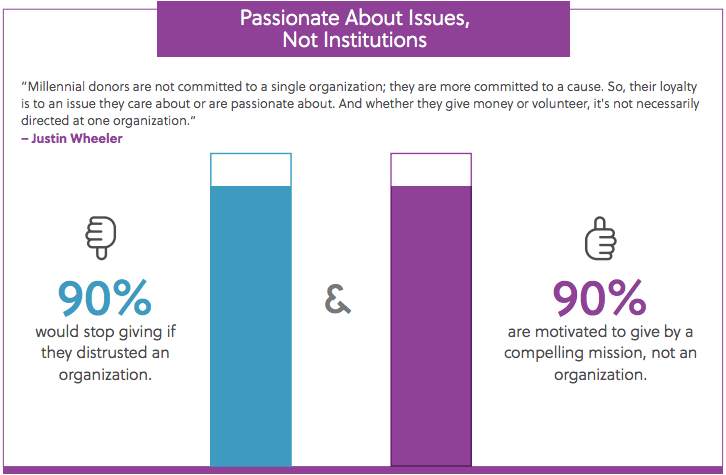Does anyone care about your organization’s brand anymore?
In 2018, The Millennial Impact Project published a report which gave truth to the rumors many of us had feared–the coveted Millennials that so many nonprofits list as their #1 audience are drawn to issues and causes over organizations. Gone are the days of Coke vs. Pepsi. For Millenials, it’s about the beverage and its overall associations vs the particular brand.
”Millennial donors are not committed to a single organization; they are more committed to a cause. So, their loyalty is to an issue they care about or are passionate about. And whether they give money or volunteer, it's not necessarily directed at one organization.”
Fear not, nonprofit friends. This news does not mean all hope is lost. Beyond passion, Millennials (and others!) are driven by trust, as the report cites that “more than 90% said they would stop giving to an organization if they began distrusting it.” So how can you build trust and hold on to the Millennials (and others) who are paying attention–even if that moment of attention is short?
Make every moment count
Every interaction someone has with your organization is a chance to shape how they feel and what they think about you. Use these moments to cement your positioning and personality (your “brand strategy”)–and also as a chance to strengthen your credibility. Millennials seek out impactful actions. Give them things to do and make those things matter. Choose actions that ladder up to your mission, provide updates as you celebrate key milestones, and report back on results, including any failures.
Respond quickly, accurately, transparently, and with information of value.
Unanswered tweets or Instagram comments can leave people with a more negative impression than your being absent from those channels completely. Be sure not to set up tools or schedule posts and forget it. Communications these days must be a conversation — you can’t shout out into the great abyss of the world and expect people to come running. You’ve got to share, post, print, podcast, film, write, ask, and more than ever before. And it’s not just about consistency and frequency–the content matters. You have to be informative, entertaining, honest, and helpful all at once. Victory goes to those who constantly engage their community.
Tap into the power of peers
Remember when your parents and teachers would tell you to watch out for peer pressure? Well, it’s still a force to be reckoned with–and it can be used for good. Millennials are more likely to donate or volunteer if a friend asks or does it with them. Give those friends tools to talk about, share, and contribute to your organization. When they make your story, their story, they’ll take more actions–and they’ll bring more friends to the party.
Show up where they are
Want to get Millennials and other folks to notice your organization? Find out where they spend time and target your efforts there. People are no longer coming to you, so go to them. And once you are there, make it clear, easy, and convenient to take action with you. From texting a pledge at concerts to signing a pledge online to making a donation with a swipe across the screen, the simpler it is, the greater the likelihood that it will happen.
Offer your thanks and appreciation
Gratitude is a good thing and I’m happy to see it making a come back. Did somebody do something for you, then say thank you. Look for ways to be creative–send stickers, pins, a virtual high-five, or even a personalized note expressing your appreciation. The more unique and customized you can be, the greater the chance someone will remember you.
Partner up
Collaboration isn’t just one of our values, it’s a winning strategy for building connections with Millenials. What organizations are fighting for the same things as your organization? The company you keep speaks volumes, and Millenials are drawn to coalitions, collectives, and partnerships. If causes and issues drive them, lean into that and showcase your work alongside like-minded efforts. You may not capture everyone’s attention, but some attention is better than none.

[Source: THE MILLENNIAL IMPACT FINAL REPORT: UNDERSTANDING HOW MILLENNIALS ENGAGE WITH CAUSES AND SOCIAL ISSUES, Achieve, Case Foundation, 2018]





